#Kimon of Athen
Explore tagged Tumblr posts
Text
Kimon of Athen he was caesars newphew, fourth degree doubly related.
#gaius julius caesar#roman#athen#Kimon of Athen#kimon#old age#how the old age worked#history#facts#very real#duhe#Gaius julius caesar and Kimon of Athen
1 note
·
View note
Photo
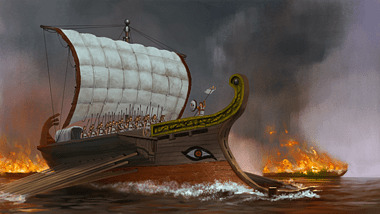
Cimon
Cimon (c. 510 – 450 BCE) was an Athenian statesman and, as strategos, frequent commander of the Athenian fleet when the city was at the height of its power. He won military glory by defeating Spartan rival Pausanias and then the Persians in both a land and sea battle to expand the membership and power of the Delian League which he led for over a decade. Not helped by his political rival Pericles, Cimon was later exiled from Athens and never recovered his former political position but he had already done enough to establish a lasting reputation as one of Athens' greatest generals. He is the subject of one of Plutarch's Lives biographies.
Early Life
Born around 510 BCE Cimon (also spelt Kimon) was the son of the general and statesman Miltiades who had famously defeated the Persians at the Battle of Marathon in 490 BCE. His mother Hegesipyle, as the daughter of Olorus, king of Thrace, was also well-to-do. Cimon's sister was Elpinice and there were accusations, now supported by some archaeological evidence, of incest between the two, even if she was married to Callias, the prominent politician. Cimon married Isodice of the Athenian aristocratic Alcmaeonid family so that with powerful family connections he was set to rise to the very top of Athens' political pile.
Continue reading...
65 notes
·
View notes
Photo

Kimon (c.510 - 450 BCE)
A few months ago, I submitted his father, Miltiades. Now it's time for the son. This handsome fellow may have been anti-democratic and a conservative elitist, but that doesn't change the fact that he returned the bones of Theseus in Athens, kicked the Persians' ass in every battle that he faced them, showed stoic badassery when it was needed and he did other cool stuffs that nobody ever talks about (which is ironic, because everybody, at least in Greece, is familiar with his father).
He was also described as being quite handsome in his youth, so that's a bonus.
94 notes
·
View notes
Text
The 3rd Messenian War happens in Sparta - A force of Athenians are sent to help - led by Kimon - who was (probably) related to Thucydides and (possibly) Demosthenes - the latter is said to have "had a special relationship with the Messenians" of Naupaktos - even in his first season of war he's clearly tight with them - the Messenians were settled in Naupaktos by Athens at the end of the 3rd Messenian War - Demosthenes sheltered at Naupaktos after he messed up in Aetolia - and it's generally agreed they prompted him to undertake the fortification of Pylos - two ships of Messenians who arrived "by chance" with necessary supplies to make those fortifications happen -

And I'm back to the lynch-pin - the situation around the battles of Sphakteria and Pylos, central to the Arkhidamian War and the culmination of forces that had been moving - fomenting - for at least thirty years. They are the continuation of the 3rd Messenian War.
What I'm trying to say is - in a really direct way, Demosthenes is the conduit that brings all of this to a head.
What I want to know is: Did he know that? Did he see it? How radicalised was he? Did he see himself as fighting for the freedom of the Messenian Helots or was he simply fighting a war by any means necessary?
#demosthenes general of athens#greek history#ancient history#when your synapses are like please please we need rest
10 notes
·
View notes
Photo
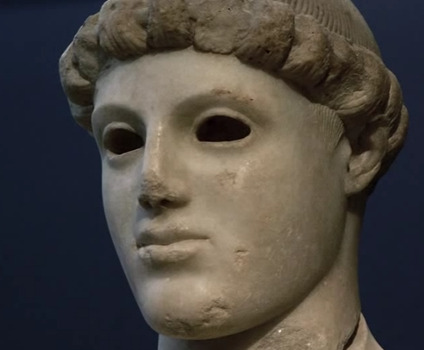
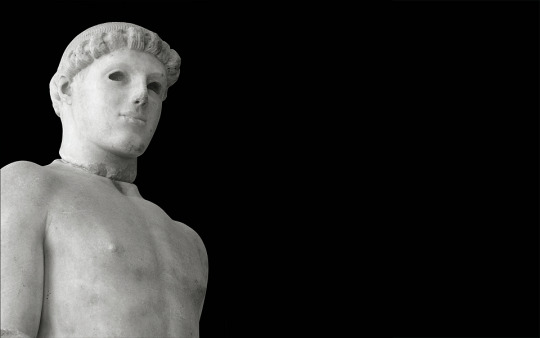
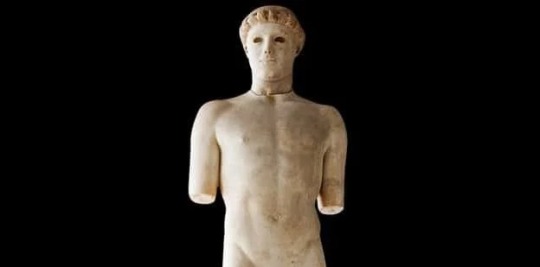
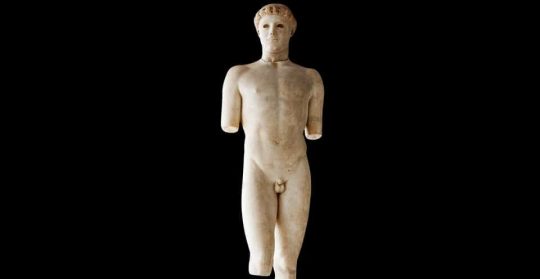

Who Beheaded the Kritios Boy, the Masterpiece of Ancient Greek Art?
The Kritios Boy, a statue displayed at the Acropolis Museum is one of the most important works of ancient Greek art and the most characteristic of the so-called “Severe Style.”
The statue’s torso was found in 1865 to 1866 southeast of the Parthenon,while the head was found in 1888 near the south walls of the Acropolis. Archaeologists have dubbed it the “Kritios Boy,” after the name of the sculptor believed to have created it.
The “Kritios Boy” is depicted standing in the nude. He supports his weight on his left leg while the right one remains bent at the knee in the characteristic posture of the Severe Style.
Ancient Greek art masterpiece
His expression is solemn and his eyes, which were originally crafted from another material, have not survived.
His hair, which follows the shape of his scalp, is tightly gathered around a ring with a few scattered strands falling on his temples and the nape of his neck. Traces of red dye are preserved on his hair.
The attribution of this statue to the sculptor Kritios is based on the similarities it presents with the statue of Harmodios from the bronze group of the Tyrannicides, a work of Kritios in collaboration with Nesiotes.
This group, known to us today through marble copies of the Roman period, was erected in the Agora of Athens.
Who this statue portrays, however, is not known. Some scholars believe he represents a young athlete, the winner of an event in the celebration of the Greater Panathenaia.
Others claim he depicts a hero, most likely Theseus. Moreover, they link the dedication of the statue on the Acropolis with the activities of 476 to 475 BC, when Kimon transferred Theseus’ bones from the island of Skyros to Athens.
Who beheaded the Kritios Boy statue?
The statue is a touchstone of Greek art. It features prominently in textbooks and it travels to major international exhibitions.
But there is still a mystery over who beheaded the statue in antiquity with an axe-blow to the back of the neck and why.
Early scholars blamed the Persians, who sacked the Acropolis during their invasion of Greece in 480 B.C. More recently, the statue has been dated to the Early Classical period by art historians; this would then imply that the Athenians themselves did the deed.
It is clear that the Athenians did, upon occasion, behead statues; there is no other explanation for the many heads (severed from their no longer preserved bodies) that have been excavated from the Acropolis fill.
Rachel Kousser, a professor of art history at the City University of New York, is pretty sure that the beheading was the work of the Persian invaders.
Writing for the Research Bulletin of The Center for Hellenic Studies, she explains:
Many of the Acropolis korai—dated prior to 480 B.C., and indisputably attacked by the Persians—have parallel injuries, including not only the blow to the back of the head, but also the missing hands and feet.
So, too, mutilation in 480 B.C. would help to explain why the Kritios Boy was interred so soon after it was set up (otherwise, one has to assume it was created in the 470s, and ‘killed’ in thirty years or less, a rather short life expectancy for a sturdy marble statue).
I would guess that the statue was set up shortly before 480, injured, and then buried—all on the Acropolis, since as an inhabitant of sacred space, it could never lose its sanctity.
But it is hard to be sure; this murder mystery from 2,500 years ago offers few clues. What we can say for certain, though, is that this ‘murder’ testifies to the significance of the image, so powerful it had to be ‘killed’ to be negated.
By Tasos Kokkinidis.
#The Kritios Boy#Who Beheaded the Kritios Boy the Masterpiece of Ancient Greek Art?#the sculptor Kritios#sculture#marble sculpture#greek marble sculpture#ancient artifacts#archeology#archeolgst#history#history news#ancient history#ancient culture#ancient civilizations#ancient greece#greek history#greek art#the parthenon
45 notes
·
View notes
Text
Giorgos Kontrafouris Trio Megaron Garden Athens Greece
Giorgos Kontrafouris Trio Megaron Garden Athens Greece
Giorgos Kontrafouris Trio The Passing – Ogdoo.gr Athens has a great variety of affordable, outdoor summer concerts, and the venues are almost as interesting as the performers. Last night I attended a jazz concert in Megaron Garden, a 4.5-acre public park. The park is noted for its “cultural and educational activities organized by the Athens Concert Hall”. Megaron is near the US Embassy and��

View On WordPress
#Athens Concert Hall#Athens Conservatory#Birdland Theater in Manhattan New York#Corfu Song Contest#Eleftherias Park#Finnish Academy of Music Sibelius#Giorgos Kontrafouris Jazz Pianist#Giorgos Kontrafouris Trio#Greek composer Manos Hatzidakis#Jason Wastor#Kenny Washington#Kimon Karoutzos#Manos Hadjidakis#Markos Alexiou#Megaron Garden Athens Greece#Ron Carter#Savvina Giannatou#The Passing
0 notes
Text


HRH Prince Odysseas Kimon of Greece and Denmark was born in London England , 17 of September of 2004 is the fourth son of the crown princes of Greece , Paul and Marie-Chantal of Greece , and therefore holds the treatment of Royal Highness and he is 5th in the line of succession to the Greek throne.
HRH Prince Odysseas Kimon of Greece and Denmark was born in Portland Hospital , London , England , on September 17 , 2004 . The prince is the grandson of kings Constantine II of Greece and Ana María of Denmark , he is a member of the Greek Royal Family . He is the fourth child of Prince Paul of Greece and his wife, Princess Marie-Chantal of Greece . He has an older sister, Princess Maria Olympia , and two older brothers, Princes Constantine Alexios , Achileas Andreasand a younger brother Prince Aristides Stavros of Greece .
Prince was baptized in Athens the 18 of June of 2005 , and the celebration took place at eleven o'clock in the Church of the Convent of St. John the Baptist in Karea under the rite of the Orthodox Church . As established in this ceremony, the little one had seven baptismal godparents: Prince Felipe of Greece , the little one's paternal uncle; Crown Princess Mette-Marit of Norway , Messrs. Nassos Thanopolous, Arki Busson and Chris Thomsen, Princess Olga of Greece and Princess Alejandra of Sayn-Wittgenstein-Berleburg. The religious ceremony was followed in the afternoon by a reception at the Greek Yacht Club in Microlimano, Athens
Ο πρίγκιπας Οδυσσέας Κίμων της Ελλάδας και της Δανίας γεννήθηκε στο Λονδίνο της Αγγλίας, στις 17 Σεπτεμβρίου 2004 είναι ο τέταρτος γιος των ΑΒΥ Πρίγκιπων Διαδόχων της Ελλάδας, Παύλου και Μαρί-Σαντάλ Πριγκίπων της Δανίας , και ως εκ τούτου κατέχει τον τίτλο της Αυτού Βασιλικής Υψηλότητας (ΑΒΥ) και είναι 5ος στη γραμμή διαδοχής του ελληνικου θρόνου.
Ο Πρίγκιπας Οδυσσέας Κίμων της Ελλάδας και Δανίας γεννήθηκε στο Νοσοκομείο Πόρτλαντ, Λονδίνο, Αγγλία, και είναι εγγονός των βασιλιάδων Κωνσταντίνου Β της Ελλάδας και Άννα Μαρίας της Δανίας, είναι μέλος της ελληνικής βασιλικής οικογένειας. Είναι το τέταρτο παιδί του Πρίγκιπα Παύλου της Ελλάδας και της συζύγου του, της πριγκίπισσας Μαρί-Σαντάλ της Ελλάδας. Έχει μια μεγαλύτερη αδερφή, την πριγκίπισσα Μαρία Ολυμπία και δύο μεγαλύτερα αδέλφια, τους πρίγκιπες Κωνσταντίνο Αλέξιο, τον Αχιλλέα Ανδρέα και έναν μικρότερο αδελφό, τον πρίγκιπα Αριστείδη Σταύρο της Ελλάδας και Δανίας .
Ο Πρίγκιπας βαφτίστηκε στην Αθήνα στις 18 Ιουνίου 2005 και ο εορτασμός πραγματοποιήθηκε στις έντεκα η ώρα στην Εκκλησία της Μονής του Αγίου Ιωάννη του Βαπτιστή στον Καρέα υπό την τελετή της Ορθόδοξης Εκκλησίας. Όπως καθιερώθηκε σε αυτή την τελετή, ο μικρός είχε επτά βαφτιστικούς νονούς: τον πρίγκιπα Φιλίππο της Ελλάδας, τον πατρικό θείο του μικρού. Η πριγκίπισσα Mette-Marit της Νορβηγίας, οι κ. Νάσος Θανοπόλους, Arki Busson και Chris Thomsen, η πριγκίπισσα Όλγα της Ελλάδας και η πριγκίπισσα Alejandra του Sayn-Wittgenstein-Berleburg. Τη θρησκευτική τελετή ακολούθησε το απόγευμα δεξίωση στο Greek Yacht Club στο Μικρολίμανο της Αθήνας
#kingconstantine#danishroyalfamily#crownprincepavlos#queenannemarie#greek royal family#house of romanov#crownprincessmariechantal#princess theodora#princessmarieolympia#princeachileasandreas#princeconstantinealexios#princenikolaos#princesstatiana#princessnina#princesseirini#princefilippos#princearistidesstavros#princeodisesskimon
6 notes
·
View notes
Photo










Greater Propylon
Eleusis, Attica, Greece
170 CE
The Greater Propylon was a monumnetal gateway into the sanctuary of Eleusis. It was probably built by Marcus Aurelius and although the face of the bust on the pediment is badly damaged, it is thought to be a portrait of the emperor. It was built on the same site as an earlier gate from the time of Kimon. It copied the central form of the Mnesiklean Propylaia in Athens.
although the face is badly damaged, it is thought to be a portrait of the emperor Marcus Aurelius who built the Greater Propylaea
It was a doric hexastyle amphiprostyle building approached by 6 steps on the east. Continuing from the east, an Ionic inner colonnade of 6 columns divided the building into 3 aisles. Beyond, was a cross wall pierced by 5 doorways. The central passage between the columns and through the doors was wider than the side passages.
Compare with original: Mnesiklean Propylaia in Athens
#art#Architecture#travel#history#greece#attica#eleusis#roman#roman art#roman architecture#propylon#Propylaea#2 b#Marcus Aurelius#gate#doric#ionic#hexastyle#amphiprostyle#statue
116 notes
·
View notes
Photo


Through the Years → Mette-Marit, Crown Princess of Norway (169/∞)
18 June 2005 | Crown Prince Haakon of Norway and his wife Crown Princess Mette-Marit arrive at the monastery of Agios Ioannis of Kareas in Athens. Royal relatives attended the christening of Odysseas-Kimon, the youngest grandson of Greece's former King Constantine. (Photo credit Louisa Gouliamako/AFP via Getty Images)
#Crown Princess Mette Marit#Norway#2005#Louisa Gouliamako#AFP via Getty Images#through the years: Mette Marit
2 notes
·
View notes
Photo

Theseus proved to be a good king. He made Athens the capital of his state, established social classes, minted coins and established the Panathenaea as the festival which symbolised the political unity of Attica. He fought off the Amazons when they attacked Athens. He lived many years, married Phaedra, and accomplished numerous feats - including escaping from the underworld, with the help of Heracles. In his later years, he formed a close friendship with the hero Perithoos. Once, though, he went to visit his kinsman king Lycomedes of Skyros, who took him up on to a high cliff, supposedly to admire the view of the island. Lycomedes treacherously pushed Theseus off the cliff and killed him. His remains were found by general Kimon and transported back to Athens and given a funeral worthy of this great hero.
#persephone#midgard#hellenistic#fantasycreature#demigod#knossos#parthenon#athena#poseidon#hercules#greekart#greekgodess#gorgon#medusa#hades#zeus#greekgods#mythologytattoo#mythologylove#pagan
2 notes
·
View notes
Photo

Kimon Athens Hotel, Афины (Греция) http://www.hotelshot.ru/2017/07/kimon-athens-hotel.html
0 notes
Text
also obvs brothers in arms and secrecrly lovers caesar the top
Kimon of Athen he was caesars newphew, fourth degree doubly related.
#gaius julius caesar#roman#athen#Kimon of Athen#kimon#old age#how the old age worked#history#facts#very real#duhe#Gaius julius caesar and Kimon of Athen#brothers in arms
1 note
·
View note